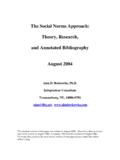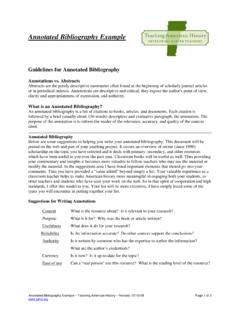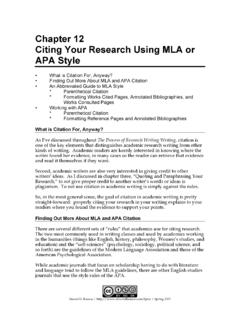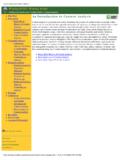Transcription of Keyboard human factors - lawrence-najjar.com
1 Najjar, L. J. (1983). Keyboard human factors : An annotated bibliography . Hanover, MD: Systems research Laboratories, Inc. September 21, 1983 Keyboard human factors : An annotated bibliography Prepared by: Lawrence J. Najjar Systems research Laboratories, Inc. Eastern Division 7320-C Parkway Dr. Hanover, MD 21076 (301) 796-7644 2 Table of Contents List of Authors and Dates of annotated Appendix A Additional Pertinent 3 Summary A search of the recent professional and technical literature was conducted to assemble information related to human factors in the design of keyboards.
2 The results of this effort are presented in the form of an annotated bibliography . 4 Introduction This document stemmed from an effort to design a computer Keyboard for a specialized wordprocessing application. Since operator comfort and performance were important considerations, the human factors literature was consulted early in the design process. Although library computer searching facilities were not employed, a thorough and careful examination of major, publicly available, professional journals, company technical reports, and popular literature was made.
3 The information garnered from this search was assembled in the form of the current annotated bibliography . The author and date of publication for each of these bibliographies are listed on the following page. This list is followed by the annotated bibliographies themselves. The documents are listed in alphabetical order, by author. Each entry includes a complete reference and a concise summary of the Keyboard human factors information that it contains. The annotated bibliographies are followed by Appendix A, which is a list of pertinent references that are either cited in the examined documents or otherwise generally considered helpful for the Keyboard designer.
4 5 List of Authors and Dates of Publication 1. Alden, Daniels, & Kanarick, 1970. 2. Cakir, Hart, & Stewart, 1980. 3. Cohen, 1982. 4. Cooper, Marston, Durrett, & Stimmel, 1982. 5. Daniels & Graf, 1970. 6. Department of Defense, 1981. 7. DIN, 1981. 8. Emmons & Hirsch, 1982. 9. Farrell & Booth, 1975. 10. Hutchingson, 1981. 11. Kinkead, 1967. 12. Kinkead & Gonzalez, 1969. 13. Moore, 1983. 14. Morgan, 1982. 15. Morgan, Williams, & Lemmons, 1983. 16. Rosinski, Chiesi, & Debons, 1980. 17. Seibel, 1972. 18. Suther & McTyre, 1982.
5 19. Whitaker & Stacey, 1981. 20. Woodson, 1981. 6 annotated Bibliographies 1. Alden, D. G., Daniels, R. W., & Kanarick, A. F. human factors principles for Keyboard design and operation A summary review. Honeywell Systems and research Center, St. Paul, Minnesota, 1970. [Note: This document was later published as: Alden, D. G., Daniels, R. W., & Kanarick, A. F. Keyboard design and operation: A review of the major issues. human factors , 1972, 14, 275-293.] Summarizes the literature of the 1960 s that is pertinent to the design of keyboards.
6 Some of the most interesting conclusions of the authors (p. 22) are: (1) Keys of in diameters, with in center-to-center distances between keys are suggested since these specifications have become fairly standard for electric typewriters. (2) Although force and displacement were found to have little effect upon keying performance, the ranges preferred by operators were: forces of to oz and displacements of to in (from Kinkead & Gonzalez, 1969). (3) Feedback, whether visual, auditory, or kinesthetic, has little effect upon the performance of experienced operators.
7 However, visual feedback is important during training and for error correction (from Deininger, 1960(a), 1960(b); Kinkead & Gonzalez, 1969). (4) Keyboard slope has little influence upon operator speed and accuracy (but Kroemer, 1964, 1965 both in German disagrees, stating that sloped keyboards improve performance). However, some inclination from the horizontal was preferred by typists. Ten to thirty-five degrees appears to be an acceptable range (Scales & Chapanis, 1954; Galitz, 1965). (5) Operator preferences do not correlate highly with performance (Kinkead & Gonzalez, 1969).
8 (6) Key and Keyboard characteristics must be evaluated in their system context for maximum validity and reliability. 2. Cakir, A., Hart, D. J., & Stewart, T. F. M. Visual display terminals. New York: Wiley, 1980. These European authors provide a thorough discussion of Keyboard design. The authors make the following statements: (1) In order to minimize reflection, keytops should be matte finished (p. 125). (2) Since square keytops provide a larger surface on which the fingers may strike, this shape keytop is preferred over circular keytops (p.)
9 125). 7 (3) A dished keytop profile is preferred over those that are stepped and sloped. Without citing a specific reference, the authors state (p. 125) that, This [dished] arrangement is reported to improve the keying rate for skilled operators and, when combined with slightly deeper depressions in the home row keys, to instil a sense of confidence in the operator. (4) The profile angle of the Keyboard should be between 5 and 15 degrees in order to minimize physiological stress in the hands and, hence, to improve keying performance (p.
10 126). (5) To reduce arm stress, it would be best to have the thinnest possible Keyboard resting directly on the thighs of a seated user (p. 126, 200). (6) Authors subscribe to the German standard of having the distance between the base of the Keyboard and the home row being 30 mm or less (p. 126). (7) Although determined primarily to be due to design convention rather than to extensive research , keytops should be square, with a size of 12-15 mm, and an intercenter spacing of 18-20 mm (p. 127). (8) The size of key legend characters should be 3 mm or greater (p.






